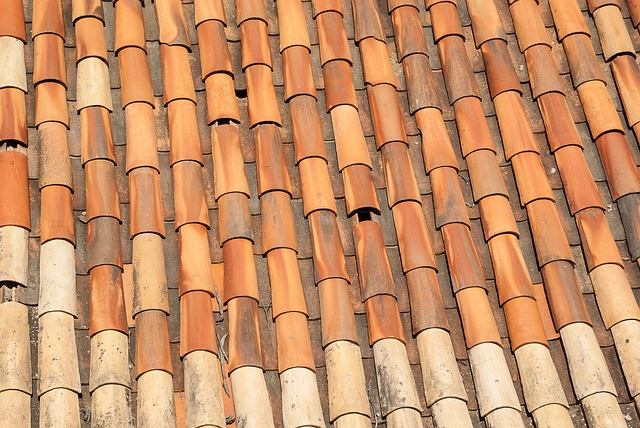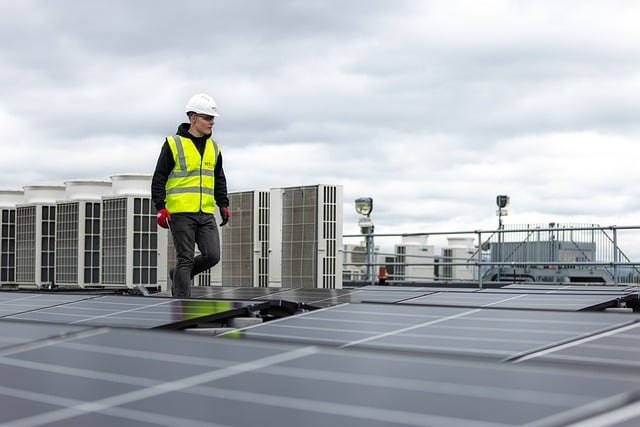A professional roof installation is crucial for structural integrity, preventing water damage, and avoiding costly future repairs. Local experts offer benefits like accessibility, tailored solutions, and knowledge of regional demands. Choosing the right materials balances functionality and aesthetics. The process involves meticulous planning, removal of old roofing, repairs to the roof deck, and strategic placement of underlayment, flashing, and primary roofing material. Mistakes like DIY jobs, neglecting maintenance, using low-quality materials, or cutting corners should be avoided. Reputable professionals use industry-standard materials and safety protocols, ensuring a durable, energy-efficient, and protected home. Regular inspections and simple DIY tasks are essential for maintaining the roof's longevity. Local experts provide specialized knowledge, competitive pricing, and guidance through regulations, making them vital for successful roof installation.
Roof Installation is a critical aspect of any property’s maintenance, offering much more than mere protection from the elements. A well-installed roof enhances a home or building’s value, ensures energy efficiency, and provides peace of mind.
This comprehensive guide delves into the world of local roof installation experts, covering everything from identifying when your roof needs replacement to choosing durable materials and understanding the steps involved in the installation process. We’ll also explore common mistakes to avoid and essential safety standards, empowering you with knowledge for successful roof projects.
Understanding the Importance of Professional Roof Installation

A professional roof installation is a critical investment for any property owner, offering more than just a protective barrier against the elements. It’s a complex process that requires expertise and precision to ensure the longevity and structural integrity of your home or building. Skilled roofing professionals understand the intricacies involved, from selecting the right materials to navigating challenging installations.
They possess the tools and knowledge to address potential issues, such as proper drainage systems and flashings, which are often overlooked but play a significant role in preventing water damage. Professional installers also guarantee high-quality work, ensuring your roof meets local building codes and safety standards. This peace of mind is invaluable, saving you from costly repairs down the line.
Identifying Signs Your Roof Needs Replacement

If your roof is showing signs of wear and tear, it might be time to consider a roof installation. One of the first indicators that your roof requires replacement is missing or damaged shingles. Over time, extreme weather conditions can take a toll on your roofing material, leading to loose or missing shingles that need immediate attention. Another visible sign is visible damage or gaps in the underlayment, which acts as a protective barrier between your roof deck and the elements. If you notice water stains or mold growth on the interior of your home, especially after heavy rainfall, it could be an early warning sign of a compromised roof.
Additionally, if your roof is old and its structure feels weak or unstable during inspections, these are red flags that replacement may be necessary. Energy bills might also provide clues; unexpected spikes in heating or cooling costs can indicate poor insulation or ventilation issues, often related to an outdated or damaged roof. When left unaddressed, these problems can lead to further damage and costly repairs, making timely identification of these signs crucial for maintaining a safe and secure home.
The Benefits of Local Experts in Roof Installation

When it comes to roof installation, turning to local experts offers a multitude of benefits that can significantly impact your decision. One of the key advantages is accessibility and convenience; local professionals are often just around the corner, ready to respond promptly to your roofing needs. This timely service is crucial in situations where quick repairs or emergency installations are required, ensuring your home remains protected.
Additionally, engaging with local roof installation experts provides a deeper connection and understanding of your region’s specific roofing demands. These specialists are familiar with the local climate, building codes, and potential challenges, allowing them to offer tailored solutions that meet your area’s unique requirements. Their knowledge translates into durable and efficient installations, ensuring your roof stands the test of time.
Choosing the Right Materials for Your Roof

When considering a roof installation, selecting the right materials is a pivotal decision that ensures your roof’s longevity and performance. Different climates demand varied roofing solutions; for instance, areas prone to heavy snow or strong winds may require sturdier, impact-resistant materials like metal or asphalt shingles designed to withstand extreme conditions. Additionally, energy efficiency is a growing concern, prompting many homeowners to opt for reflective or insulated roofing options that can lower cooling costs.
Material choices also extend beyond functional considerations, offering aesthetic possibilities. From traditional slate to contemporary composite materials, the visual appeal of your roof plays a significant role in enhancing your home’s overall curb appeal. Consulting with local roof installation experts can provide valuable insights into regional climate demands and design trends, ensuring you make an informed decision that complements both functionality and aesthetics for your property.
Steps Involved in a Typical Roof Installation Process

A roof installation is a complex process that requires careful planning and execution. It typically involves several crucial steps to ensure a sturdy and durable structure. Firstly, the old roofing material is removed, taking care not to damage the underlying surface. This may include stripping off shingles, tearing down tar paper, or deconstructing flat roofs. Once cleared, the roofers inspect the deck for any repairs needed, ensuring it’s in good condition.
Next, new materials are measured and cut to size. This includes underlayment, flashing, and of course, the roofing shingles or tiles. The underlayment is secured to the deck, providing an extra layer of protection against moisture. Flashing is installed along the roof’s edges and around chimneys or vents, sealing any potential entry points for water. After these layers are in place, the actual roofing material is fitted, starting from the bottom edge and working upwards, ensuring proper overlap and secure fastening.
Common Mistakes to Avoid During Roof Installation

When it comes to roof installation, there are several common mistakes that homeowners often make, which can lead to future issues and costly repairs. One of the biggest blunders is attempting a DIY job without proper knowledge and experience. Roofs are complex structures, and any errors during installation can have severe consequences, including water damage, reduced energy efficiency, and structural weaknesses. It’s always best to hire licensed professionals for the task.
Another mistake to avoid is neglecting regular maintenance checks. Over time, roofs can develop cracks, loose shingles, or damaged flashing, which are critical components of a secure roof system. Regular inspections can help identify these issues early on, making repairs more manageable and less expensive. Additionally, using low-quality materials or cutting corners during the installation process can result in a weak and unreliable roof, so it’s essential to invest in durable, high-standard materials and adhere to expert installation practices.
Ensuring Quality and Safety Standards in Roof Work

When it comes to roof installation, ensuring quality and safety standards is paramount. Reputable roofing experts prioritize using high-quality materials that meet industry standards to guarantee durability and longevity. They also adhere to stringent safety protocols to protect both their team and your property during the installation process. This includes proper ventilation, secure scaffolding, and the use of personal protective equipment (PPE).
By maintaining rigorous quality and safety measures, local roof installation experts ensure that your new roof not only looks stunning but also performs optimally. This translates to increased energy efficiency, better protection against harsh weather conditions, and peace of mind knowing your investment is in safe hands.
Maintenance Tips for Long-Lasting Roofs

Maintaining your roof is essential for ensuring its longevity and preserving the integrity of your home. Regular inspections are key; look for any signs of damage, leaks, or loose shingles. Addressing issues early can prevent small problems from turning into major repairs.
Simple DIY tasks like clearing gutters of debris and checking for blocked downspouts can go a long way in protecting your roof. Additionally, consider sealing cracks and gaps around vents and chimneys to prevent moisture intrusion. Using high-quality materials during initial roof installation sets the stage for durability, but ongoing maintenance is vital to keeping your roof in top shape.
Local Resources and Support for Roof Installation Projects

When tackling a roof installation project, leveraging local resources can significantly enhance the experience and outcome. Local roofing experts not only offer specialized knowledge but also provide access to high-quality materials sourced closer to home. This reduces delivery times and ensures you get the best deals, as local suppliers often have promotions tailored for neighborhood projects. Moreover, engaging with your community supports local businesses and fosters a stronger connection to your surroundings.
These experts are also deeply familiar with local building codes and regulations, which can be complex and vary by region. They can guide you through permitting processes and ensure your roof installation complies with safety standards, avoiding potential fines or structural issues down the line. Their insights into climate-specific roofing solutions can help protect your investment for years to come, making them invaluable assets in any roof installation endeavor.
